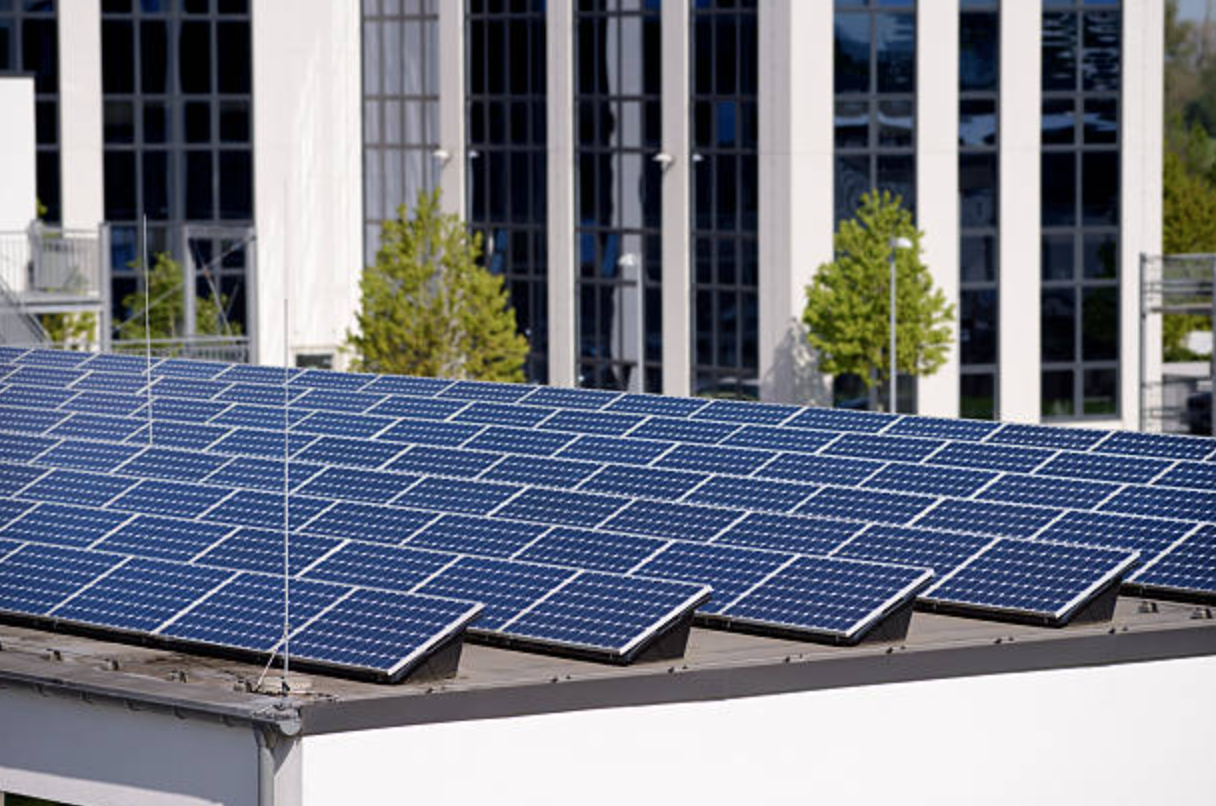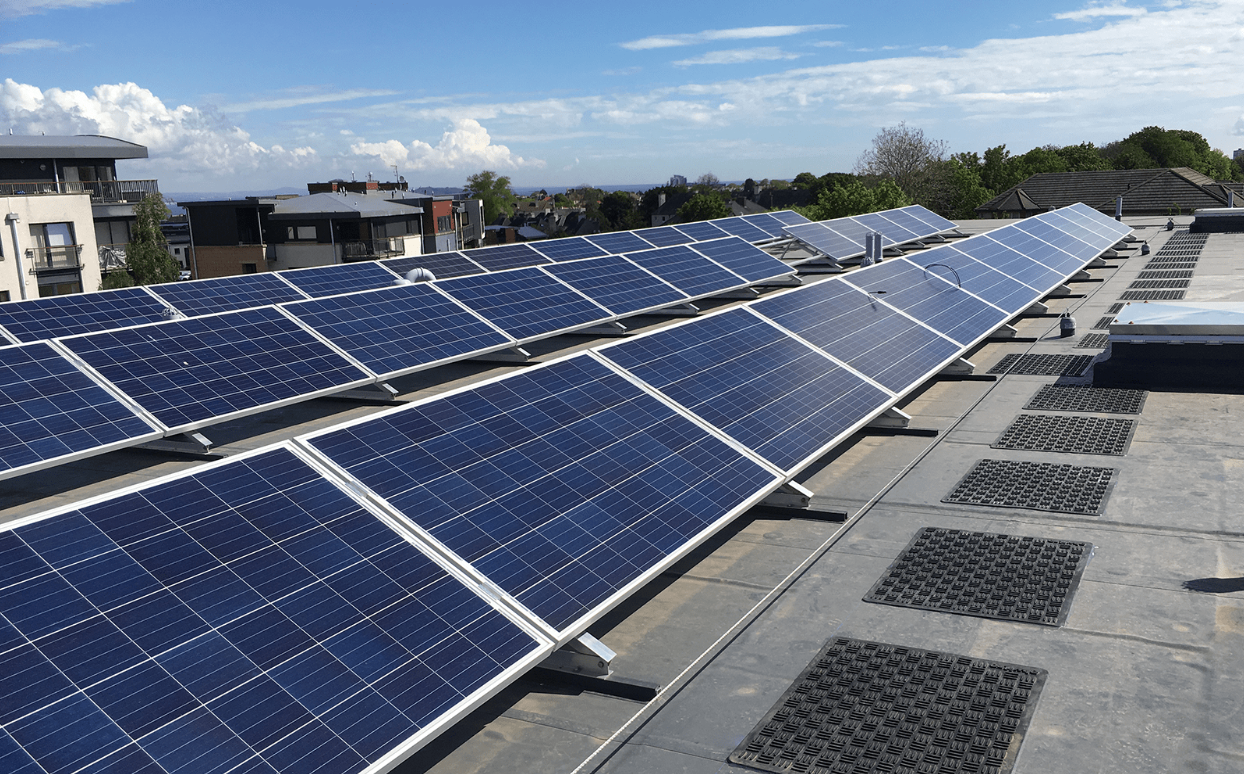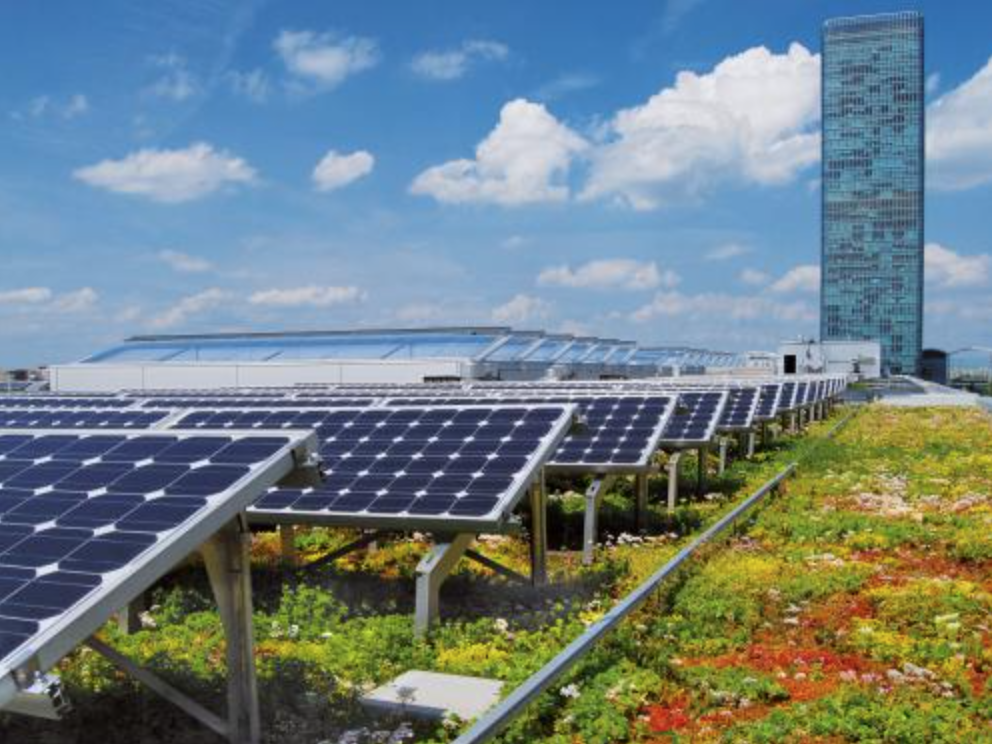Top Benefits of Solar Panels for Commercial Buildings
Dean Emerick
February 16, 2023

Thinking about adding solar panels to your commercial building? While solar panels have long been popular for residential buildings, they are now increasingly being adopted for commercial buildings due to their scalability and financial benefits. They're not just great for cutting electricity costs; they also help your business go greener and more sustainable. In this guide, we'll walk you through how commercial solar works, its costs, the financial benefits, and more.
Key Takeaways
- Commercial solar panels convert sunlight into electricity as part of a commercial solar energy system using the photovoltaic effect, enabling businesses to reduce energy costs and improve sustainability.
- The financial benefits of solar installations include reduced electricity bills, tax credits like the Investment Tax Credit (ITC), and potential income from selling excess energy back to the grid.
- Commercial solar systems require minimal maintenance, have a long lifespan, and have a strategic placement that can maximize energy production and return on investment.
Do Solar Panels Work for Commercial Buildings?
Yes, solar panels are a reliable and effective option for commercial buildings. Whether you're powering an entire office, a warehouse, or even just specific operations like lighting or security systems, solar energy can help businesses take better control of their energy supply while cutting long-term costs.
One of the key advantages of solar energy is its flexibility. A well-designed PV system can be tailored to meet your building's specific energy demands, whether large or small. Many commercial properties are already taking advantage of this technology to reduce their dependence on fossil fuels and to avoid the rising costs tied to traditional utility companies. By generating solar electricity on-site, businesses can significantly lower their utility bills, making solar a practical solution for both cost savings and energy independence.

How Commercial Solar Panels Work
Every commercial solar system works by turning sunlight into usable electricity, and it all starts with the solar panels. These panels are made up of silicon cells that react when the sun's rays hit them, triggering the photovoltaic effect. As the light hits the surface, it sets off a reaction that causes electrons to move, which creates an electric current. This process is called the photovoltaic effect, and it's what makes solar energy possible in any PV system.
A solar array, consisting of multiple interconnected panels, is responsible for capturing and converting solar energy for the building.
A typical commercial solar installation comprises three key components:
- Solar Panels: These are the most visible parts of the system and do the important job of capturing sunlight. Inside each panel are silicon cells that convert sunlight into direct current (DC) electricity.
- Inverters: Since most buildings run on alternating current (AC), the system needs inverters to make that switch. Inverters take the DC electricity from the panels and convert it into AC, making the energy usable for lighting, equipment, and everything else your business runs on.
- Energy Storage Systems: Battery storage is becoming more common in commercial solar systems. These systems store any excess energy your panels generate during the day, so you can use it later, like during the night or peak hours.

Most commercial solar systems connect to the local power grid for seamless power integration. This setup allows businesses to access grid power during low solar production and send excess power back to the grid when they produce power, utilizing a solar power system through net metering.
Site evaluation is a crucial initial step to assess potential energy generation based on location and structural conditions.
Types of Commercial Solar Energy Systems
When it comes to powering commercial buildings with solar energy, there's no one-size-fits-all approach. Businesses have a few great options, and the right choice depends on available space, energy needs, and long-term goals.
Below are the most common types of commercial solar systems and what makes each of them effective. Selecting the right system is a crucial step in any commercial solar project, as it impacts costs, efficiency, and long-term benefits.
While most commercial installations are rooftop or ground-mounted systems, larger-scale solar farm projects are also an option for businesses with significant land resources and energy needs.
Rooftop Solar Systems
Rooftop solar is one of the most popular choices for commercial solar installations, especially for buildings with large, flat roofs. Roofs over 50,000 square feet can support sizable commercial solar power systems that generate significant power without taking up additional land.
This type of system is especially practical in urban settings where open ground is limited. Rooftop systems are typically easier to permit and install, making them a cost-effective way to lower electricity bills and reduce your carbon footprint with solar power.

Ground-Mounted Solar Systems
For businesses with unused land, like open lots, brownfields, or capped landfills, ground-mounted systems can be a smart option. These commercial solar systems are installed directly into the ground and can be positioned at angles that capture sunlight more efficiently throughout the year.
Another key advantage is accessibility. Since the panels aren't on the roof, maintenance and upgrades are usually easier and safer to carry out. For commercial buildings with room to spare, this setup can be a reliable, high-output solution that enhances energy savings over time.

Solar Parking Canopies
Solar parking canopies are an innovative solution that combines energy generation with practical infrastructure. These solar arrays are built over parking areas and provide covered, shaded spots for vehicles while also powering the building.
Not only do they add comfort for employees and visitors, but they're also a visible sign of your company's commitment to sustainability. Many businesses find that these dual-purpose commercial solar power systems offer both aesthetic appeal and energy efficiency, especially in busy commercial properties where every square foot matters.

Understanding the different types of solar panel systems and how they align with your business operations can help you make a smarter investment.
It's also worth considering the upfront cost of commercial solar panels compared to long-term savings. An experienced solar provider can help design a system that meets your unique needs and maximizes your return on investment.
Cost of Installing Commercial Solar Panels
Commercial solar panel costs can vary widely, influenced by factors such as system size, panel efficiency, and installation complexity. Average solar installation costs for commercial projects were astonishingly low per watt, reflecting a significant decrease over the years.
Larger systems, while initially more expensive, offer greater energy production and long-term savings, impacting the commercial solar panel cost.
Several factors influence the overall cost, including:
- The type of solar panels used
- Inverter technology
- Labor
- Permitting
- Mounting requirements
Working with reputable manufacturers ensures the quality and reliability of your commercial solar system, which can impact both upfront costs and long-term performance.
High-efficiency panels may have a higher upfront cost but can contribute to reduced long-term expenses through greater energy production. Additionally, the installation costs and location affect labor costs due to varying labor needs and more panels, as installing more panels increases both material and labor costs.
Financial incentives such as tax credits and local rebates can considerably reduce the upfront costs of commercial solar panel installations. Despite the high initial investment, the long-term benefits, including substantial cost savings on electricity bills, make it a worthwhile endeavor for many businesses.
Financial Benefits of Commercial Solar Panels
One of the most compelling reasons for businesses to invest in commercial solar panels is the financial benefits. The federal government offers a tax credit for commercial solar panel installations, significantly reducing the upfront cost.
Many states also provide specific rebates that further lower the overall cost, including potential tax breaks.
Solar energy can benefit businesses in several ways:
- Significantly reduce or even eliminate monthly electricity bills and electricity expenses, resulting in substantial long-term savings and potential energy independence.
- Generate income by selling surplus excess energy back to the grid.
- Earn renewable energy certificates (RECs) while monitoring energy usage and utilizing a renewable energy source.
Many businesses recoup their initial investment within a few years, making commercial solar installations a cost-effective solution that provides net savings over time. Once the system is paid off, businesses can benefit from free power generated by their solar panels, further increasing long-term savings.
This rapid return on investment, combined with ongoing cost savings, makes solar energy a financially sound decision for commercial properties.
Access to Tax Breaks and Incentives
One of the most attractive benefits of installing commercial solar panels is the access to substantial tax breaks and incentives. The federal government currently offers an Investment Tax Credit (ITC) for businesses that invest in solar panels, allowing companies to deduct a significant portion of their initial investment from their federal income taxes.
This tax credit can dramatically lower the commercial solar panels cost, making the transition to renewable energy much more affordable.
Beyond the federal ITC, many states and local governments provide additional tax credits, rebates, and financial incentives to encourage the adoption of solar power. These programs can further reduce the upfront costs of a commercial solar installation and help businesses save money on their electricity bills from day one.
By leveraging these tax breaks and incentives, companies not only cut costs but also demonstrate a commitment to sustainability by reducing their carbon footprint. Taking advantage of these opportunities can make commercial solar a smart financial and environmental decision for any business.
Environmental and Brand Benefits

Switching to commercial solar panels does more than just lower operating costs. It sends a clear message about your company's values. By cutting down on your business's carbon footprint and reducing your reliance on fossil fuels, solar panels can significantly reduce a building's carbon footprint by lowering greenhouse gas emissions associated with energy use, so your business actively contributes to a cleaner, healthier environment.
This kind of commitment to sustainability can also do wonders for your brand. Customers, partners, and even employees tend to view businesses that invest in clean energy as more responsible and forward-thinking. It builds trust and attracts eco-conscious consumers who prefer supporting companies that align with their values.
Some organizations, like Mauna Loa, have fully embraced renewable energy and are setting powerful examples for the rest of the industry. These efforts don't just support the planet—they also shape positive public perception and help meet broader corporate social responsibility goals.
In a market where reputation matters, going solar can give your business a real competitive edge. It shows leadership, sparks interest, and opens doors to new opportunities, all while doing something genuinely good.
Maintenance and Longevity of Commercial Solar Panels
Commercial solar panels are appealing due to their very little maintenance requirements. The absence of moving parts in solar panels reduces the likelihood of breakdowns and minimizes maintenance needs. Having solar panels installed by experienced professionals ensures optimal placement and long-term reliability. Routine maintenance usually includes periodic light cleanings and regular inspections to maintain optimal performance.
High-quality solar panels have a typical lifespan of around 25 to 30 years or more. Regular maintenance tasks can maintain efficiency and performance.
Certified professionals can identify potential performance issues through annual inspections, ensuring the system operates at its best. Key points include:
- Regular energy output monitoring is crucial to detect performance drops and minimize unexpected system downtime.
- Commercial solar panels have little or no operating costs after installation.
- They offer long-term savings and reliability.
Maximizing Return on Investment
Maximizing the return on investment (ROI) from commercial solar panels involves several strategies. Routine maintenance is essential to ensure the system operates efficiently and continues to provide significant cost savings. Strategic placement of solar panel arrays for maximum sunlight exposure can also enhance energy production and financial returns.
Ways to reduce costs and improve returns on solar investments include:
- Federal incentives like the Investment Tax Credit can be utilized to significantly lower the overall cost.
- Monitoring usage data to optimize performance and identify areas for further cost savings.
- Managing installation with in-house staff to further cut costs and speed up the ROI.
The typical payback period for a large solar power plant ranges from 5 to 8 years. Calculating the payback period and considering estimated project costs help businesses make informed solar investment decisions. Avoiding oversizing solar arrays protects the investment and maximizes potential savings.
Summary
In summary, the benefits of commercial solar panels are extensive and compelling. From significant cost savings and financial incentives to environmental impact and enhanced brand reputation, solar energy offers a multitude of advantages for businesses. The technology is reliable, has low maintenance requirements, and has a long lifespan, ensuring consistent performance and savings over time.
As we move towards a more sustainable future, adopting solar energy is not just a smart financial decision but a vital step in reducing our carbon footprint and promoting environmental stewardship. Businesses that invest in solar panels can achieve substantial long-term benefits and position themselves as leaders in sustainability.
Frequently Asked Questions
How do commercial solar panels work?
Commercial solar panels function by converting sunlight into electricity through silicon cells, which produce direct current (DC) that is transformed into alternating current (AC) by inverters for use in business operations. This process allows businesses to harness renewable energy effectively.
What are the different types of commercial solar energy systems?
The different types of commercial solar energy systems are rooftop solar systems, ground-mounted systems, and solar parking canopies, each offering unique advantages tailored to specific business needs and available space. Ultimately, selecting the right type will depend on your business's individual requirements and constraints.
What factors influence the cost of installing commercial solar panels?
The cost of installing commercial solar panels is influenced by factors such as system size, panel efficiency, inverter technology, installation complexity, and financial incentives. On average, the cost per watt for these installations is approximately $1.44.
What are the financial benefits of commercial solar panels?
The financial benefits of commercial solar panels are significant, including tax credits, reduced electricity bills, potential income from selling excess energy, and long-term savings. Businesses can frequently recover their initial investment within a few years, making it a worthwhile financial decision.
How long do commercial solar panels last, and what maintenance is required?
Commercial solar panels generally last between 25 to 30 years or more. Maintenance requires periodic light cleaning and regular inspections to maintain optimal performance.



